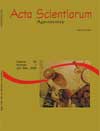<strong>Substrata fertilized with coated urea and the growth and nutritional state of the young citrus tree<strong>
Keywords:
slow release fertilizers, agro-industrial residues, propagation, Citrus reshni, Citrus sinensis
Abstract
Two experiments were carried out with the objective of evaluating the growth and nutritional state of the young citrus tree in function of different levels of coated urea (UR). In the first experiment, carried out from transplanting (01/2006) up to the budding point (06/2006), five levels of UR were evaluated (0, 0.5, 1.0, 2.0 and 4.0 kg m-³ of substratum) and two substrata (Plantmax® and another obtained from sugar cane bagasse + filter cake – BT). In the second experiment, carried out from budding until the pinch out point (12/2006), five doses of UR in substratum BT were evaluated. The budding point was reached 120 days after the transplanting in the plants cultivated in substratum BT, while in Plantmax® it was not reached. The concentration of N in the rootstock leaves cultivated in substratum BT increases with the doses of UR. Major diameter and N concentration in the plants cultivated in substratum Plantmax® were observed in a level of 2.4 kg m-3. Using the substratum BT with the characteristics described in this experiment, it is possible to attain the rootstock ‘Cleópatra’ mandarin in the budding point at 159 days after the transplanting and the young ‘Seleta’ orange tree, budded on it, at 182 days after budding, without nitrogen fertilization supplementation with coated urea.Downloads
Download data is not yet available.
Published
2009-03-19
How to Cite
Azevedo, E. B., Marinho, C. S., Muniz, R. de A., & Carvalho, A. J. C. de. (2009). <strong>Substrata fertilized with coated urea and the growth and nutritional state of the young citrus tree<strong>. Acta Scientiarum. Agronomy, 31(1), 129-137. https://doi.org/10.4025/actasciagron.v31i1.6639
Issue
Section
Crop Production
DECLARATION OF ORIGINALITY AND COPYRIGHTS
I Declare that current article is original and has not been submitted for publication, in part or in whole, to any other national or international journal.
The copyrights belong exclusively to the authors. Published content is licensed under Creative Commons Attribution 4.0 (CC BY 4.0) guidelines, which allows sharing (copy and distribution of the material in any medium or format) and adaptation (remix, transform, and build upon the material) for any purpose, even commercially, under the terms of attribution.
2.0
2019CiteScore
60th percentile
Powered by 

2.0
2019CiteScore
60th percentile
Powered by 



















































